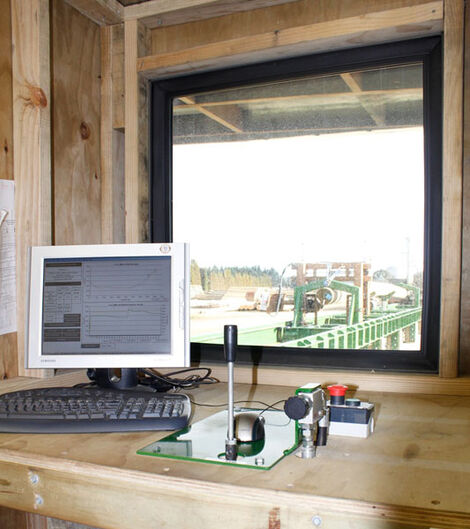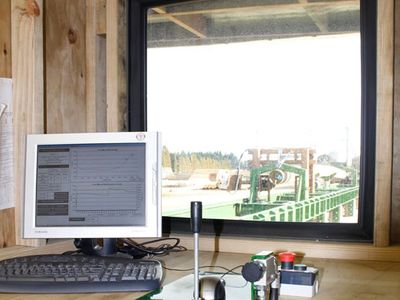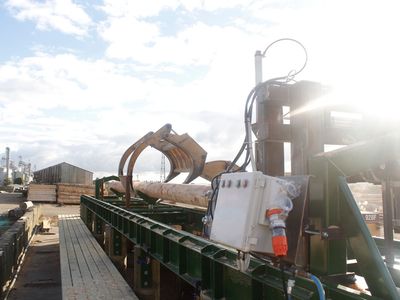
®
TTTested Poles are High Strength poles. We call them High Strength because their strength has been verified on our purpose-built Certified Pole Testing rig. TTT Poles such as SED, Uglies or MultiPoles can be proof-tested.
All TTT Poles are manufactured in accordance with NZS 3605:2001 Timber Poles and Piles for Use in Building, and NZS 3603:1993 Timber Structures Standard. Both these Standards allow for two categories of poles – Normal Category and High Category:
- Normal Category poles are the standard poles that are supplied every day and provide a minimum characteristic bending stress (fb) of 38Mpa, with the outer zone density expected to be a minimum of 350kg/m3. Studies of NZ Radiata Pine forests have demonstrated generally that all forests which supply logs for poles are shown to have a minimum density of 350kg/m3, which satisfactorily achieves the Normal Category.
- High Category poles need to provide a higher characteristic bending stress of a minimum of 52Mpa and as such require additional verification. To establish whether poles qualify as High Category either they need to have a proven outer zone density of at least 450 kg/m3, or they need to be proof-tested to prove their strength. These are the only acceptable methods of verifying High Category according to the Standards.
Proof-testing vs Outer Zone Density
The density of wood from New Zealand Radiata Pine forests is known to vary. Even logs grown side by side within the same forest can vary in terms of density. Density is affected by a number of factors including forest management practices, growing conditions, and the age of the trees.
To prove the outer zone density of a pole it is necessary to cut a sample from the pole and send it to a laboratory to be analysed. The process of accurately analysing density can only be carried out by a laboratory and the results generally take time.
Proof-testing on the other hand involves testing a pole on a pole testing rig and receiving an instant result.
There are other methods purported to provide density readings, but as yet these are not acknowledged within the Standards. Only outer zone density and proof-testing are acceptable methods that comply with the Standards.
The Pole Proof-testing Process
At TTT we have always been progressive in our manufacturing methods. We were so determined to find a way to provide verified High Strength poles that we designed and built our very own Certified Pole Testing rig. This specialised rig is independently calibrated to ensure reliable proof-test results.
Proof-testing is carried out at the very beginning of the manufacturing process, with no damage to the pole, and immediate results available. Proof-testing involves loading a pole into the pole testing rig, applying a proof force by way of an hydraulic ram to achieve the required force in 3-30 seconds, and maintaining the proof force for at least 15 seconds with the pole showing no signs of distress.
Modification factors to account for characteristic stresses are applied in accordance with NZS 3603:1993 (refer to Table 7.1 – Characteristic stresses (MPa) and modulus of elasticity (GPa) for naturally round softwood timber in green condition).
We use a three-point bending test method with the force being applied at the assumed groundline point (unless advised, we assume this groundline location to be approximately halfway down the length of the pole). Poles are tested in the raw, unprocessed condition.
Alongside our Certified Pole Testing rig we developed specialised software that applies the relevant modification factors and automatically calculates the modified characteristic bending stress required in strict accordance with NZS 3605:2001. Each pole is tested to the required proof loading.
On completion of the proof-test each TTT Pole is tagged with an individual tag number confirming it is High Strength.
Use TTTested Poles in any situation that requires a High Strength pole as specified by your engineer or specifier, whether for construction, retaining walls, power transmission, or telecommunications poles.

Use TTTested Poles specifically for:
- Situations where High Strength poles have been specified by your engineer or specifier
- Construction & Retaining Walls
- Foundations
- Installation via Pile Driving, Drilling & Concreting, or Vibration
TTT Quick Info:
- Radiata Pine
- TTT SED Poles, TTT Uglies, TTT MultiPoles
- Diameter range: 150mm to 500mm SED *
- Length range: 1.8m to 18m long *
- H5 Hazard Class, CCA
- Complies with NZS3605:2001 Timber Piles and Poles for Use in Building
- Complies with NZS3640:2003 Chemical Preservation of Round and Sawn Timber
- Manufactured to order
- * Not all size/diameter combinations are suitable for proof-testing
No videos for this product....


